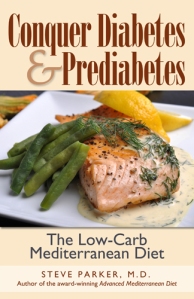A Paleolithic diet lowered blood sugar levels better than a control diet in coronary heart disease patients with elevated blood sugars, according to Swedish researchers reporting in 2007.
 About half of patients with coronary heart disease have abnormal glucose (blood sugar) metabolism. Lindeberg and associates wondered if a Paleolithic diet (aka “Old Stone Age,” “caveman,” or ancestral human diet) would lead to improved blood sugar levels in heart patients, compared to healthy, Mediterranean-style, Western diet.
About half of patients with coronary heart disease have abnormal glucose (blood sugar) metabolism. Lindeberg and associates wondered if a Paleolithic diet (aka “Old Stone Age,” “caveman,” or ancestral human diet) would lead to improved blood sugar levels in heart patients, compared to healthy, Mediterranean-style, Western diet.
Methodology
Investigators at the University of Lund found enrolled 38 male heart patients—average age 61—patients and randomized them to either a paleo diet or a “consensus” (Mediterranean-like) diet to be followed for 12 weeks. Average weight was 94 kg. Nine participants dropped out before completing the study, so results are based on 29 participants. All subjects had either prediabetes or type 2 diabetes (the majority) but none were taking medications to lower blood sugar. Baseline hemoglobin A1c’s were around 4.8%. Average fasting blood sugar was 125 mg/dl (6.9 mmol/l); average sugar two hours after 75 g of oral glucose was 160 mg/dl (8.9 mmol/l).
The paleo diet was based on lean meat, fish, fruits, leafy and cruciferous vegetables, root vegetables (potatoes limited to two or fewer medium-sized per day), eggs, and nuts (no grains, rice, dairy products, salt, or refined fats and sugar).
The Mediterranean-like diet focused on low-fat dairy, whole grains, vegetables, fruits, potatoes, fatty fish, oils and margarines rich in monounsaturated fatty acids and alpha-linolenic acid.
Both groups were allowed up to one glass of wine daily.
No effort was made to restrict total caloric intake with a goal of weight loss.
Results
Absolute carbohydrate consumption was 43% lower in the paleo group (134 g versus 231 g), and 23% lower in terms of total calorie consumption (40% versus 52%). Glycemic load was 47% lower in the paleo group (65 versus 122), mostly reflecting lack of cereal grains.
The paleo group ate significantly more nuts, fruit, and vegetables. The Mediterranean group ate significantly more cereal grains,oil, margarine, and dairy products.
Glucose control improved by 26% in the paleo group compared to 7% in the consensus group. The improvement was statisically significant only in the paleo group. The researchers believe the improvement was independent of energy consumption, glycemic load, and dietary carb/protein/fat percentages.
High fruit consumption inthe paleo group (493 g versus 252 g daily) didn’t seem to impair glucose tolerance.
Hemoglobin A1c’s did not change or differ significantly between the groups.
Neither group showed a change in insulin sensitivity (HOMA-IR method).
Comments
The authors’ bottom line:
In conclusion, we found marked improvement of glucose tolerance in ischemic heart disease patients with increased blood glucose or diabetes after advice to follow a Palaeolithic [sic] diet compared with a healthy Western diet. The larger improvement of glucose tolerance in the Palaeolithic group was independent of energy intake and macronutrient composition, which suggests that avoiding Western foods is more important than counting calories, fat, carbohydrate or protein. The study adds to the notion that healthy diets based on whole-grain cereals and low-fat dairy products are only the second best choice in the prevention and treatment of type 2 diabetes.
This was a small study; I consider it a promising pilot. Results apply to men only, and perhaps only to Swedish men. I have no reason to think they wouldn’t apply to women, too. Who knows about other ethnic groups?
This study and the one I mention below are the only two studies I’ve seen that look at the paleo diet as applied to human diabetics. If you know of others, please mention in the Comments section.
The higher fruit consumption of the paleo group didn’t adversely affect glucose control, which is surprising. Fruit is supposed to raise blood sugar. At 493 grams a day, men in the paleo group ate almost seven times the average fruit intake of Swedish men (75 g/day). Perhaps lack of adverse effect on glucose control here reflects that these diabetics and prediabetics were mild cases early in the course of the condition—diabetes tends to worsen over time.
 Present day paleo and low-carb advocates share a degree of simpatico, mostly because of carbohydrate restriction—at least to some degree—by paleo dieters. Both groups favor natural, relatively unprocessed foods. Note that the average American eats 250-300 g of carbohydrates a day. Total carb intake in the paleo group was 134 g (40% of calories) versus 231 g (55% of calories) in the Mediterranean-style diet. Other versions of the paleo diet will yield different numbers, as will individual choices for various fruits and vegetables. Forty percent of total energy consumption from carbs barely qualifies as low-carb.
Present day paleo and low-carb advocates share a degree of simpatico, mostly because of carbohydrate restriction—at least to some degree—by paleo dieters. Both groups favor natural, relatively unprocessed foods. Note that the average American eats 250-300 g of carbohydrates a day. Total carb intake in the paleo group was 134 g (40% of calories) versus 231 g (55% of calories) in the Mediterranean-style diet. Other versions of the paleo diet will yield different numbers, as will individual choices for various fruits and vegetables. Forty percent of total energy consumption from carbs barely qualifies as low-carb.
Study participants were mild, diet-controlled diabetics or prediabetics, not representative of the overall diabetic population, most of whom take drugs for it and have much higher hemoglobin A1c’s.
Lindeberg and associates in 2009 published results of a paleo diet versus standard diabetic diet trial in 13 diabetics. Although a small trial (13 subjects, crossover design), it suggested advantages to the paleo diet in terms of heart disease risk factors and improved hemoglobin A1c. Most participants were on glucose lowering drugs; none were on insulin. Glucose levels were under fairly good control at the outset. Compared to the standard diabetic diet, the Paleo diet yielded lower hemoglobin A1c’s (0.4% lower—absolute difference), lower trigylcerides, lower diastolic blood pressure, lower weight, lower body mass index, lower waist circumference, lower total energy (caloric) intake, and higher HDL cholesterol. Glucose tolerance was the same for both diets. Fasting blood sugars tended to decrease more on the Paleo diet, but did not reach statistical significance (p=0.08).
The paleo diet shows promise as a treatment or preventative for prediabetes and type 2 diabetes. Only time will tell if it’s better than a low-carb Mediterranean diet or other low-carb diets.
Steve Parker, M.D.
Reference: Lindeberg, S., Jönsson, T., Granfeldt, Y., Borgstrand, E., Soffman, J., Sjöström, K., & Ahrén, B. (2007). A Palaeolithic diet improves glucose tolerance more than a Mediterranean-like diet in individuals with ischaemic heart disease Diabetologia, 50 (9), 1795-1807 DOI: 10.1007/s00125-007-0716-y














